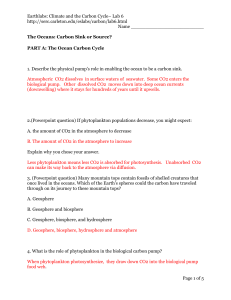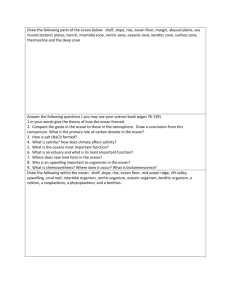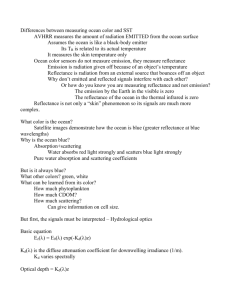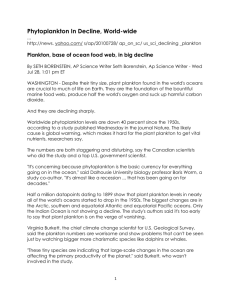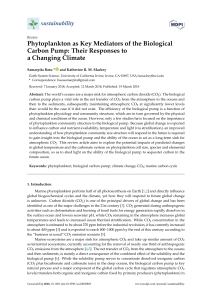Oceans and the Carbon Cycle
advertisement
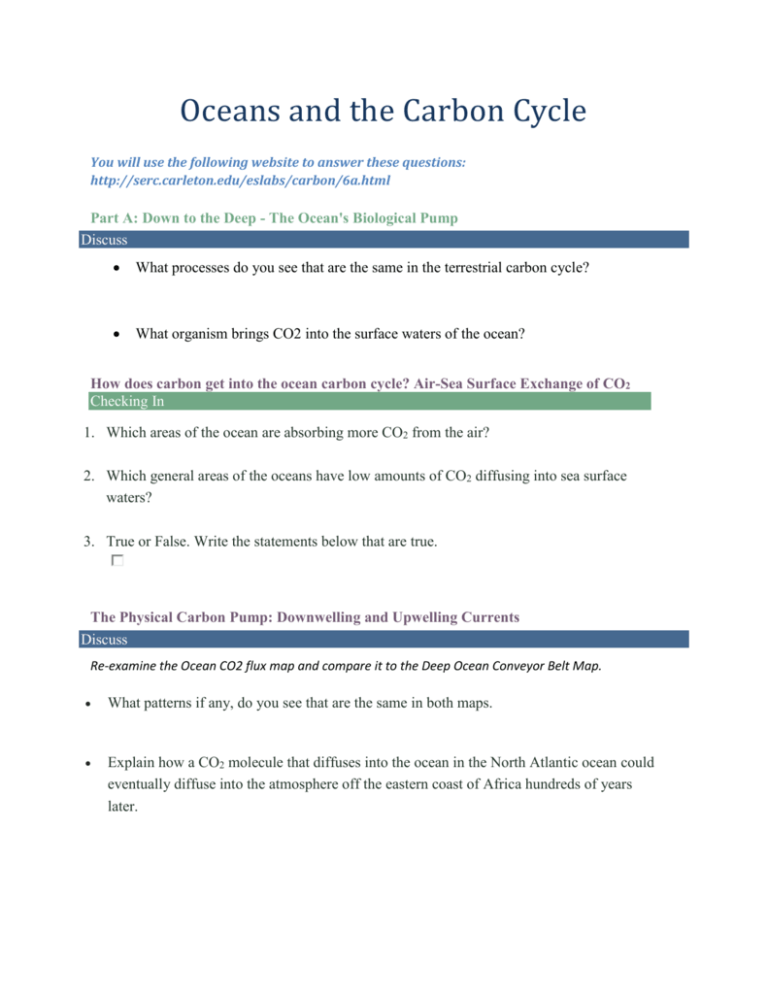
Oceans and the Carbon Cycle You will use the following website to answer these questions: http://serc.carleton.edu/eslabs/carbon/6a.html Part A: Down to the Deep - The Ocean's Biological Pump Discuss What processes do you see that are the same in the terrestrial carbon cycle? What organism brings CO2 into the surface waters of the ocean? How does carbon get into the ocean carbon cycle? Air-Sea Surface Exchange of CO2 Checking In 1. Which areas of the ocean are absorbing more CO2 from the air? 2. Which general areas of the oceans have low amounts of CO2 diffusing into sea surface waters? 3. True or False. Write the statements below that are true. The Physical Carbon Pump: Downwelling and Upwelling Currents Discuss Re-examine the Ocean CO2 flux map and compare it to the Deep Ocean Conveyor Belt Map. What patterns if any, do you see that are the same in both maps. Explain how a CO2 molecule that diffuses into the ocean in the North Atlantic ocean could eventually diffuse into the atmosphere off the eastern coast of Africa hundreds of years later. Stop and Think 1: Describe the physical pump's role in enabling the ocean to be a carbon sink. Phytoplankton and the Oceanic Biological Carbon Pump: Tiny Organisms, Big Role! Checking In Look at the simplified image of the oceanic biological carbon pump above right. 1. Draw a carbon pathway with the shortest time scale between two reservoirs. 2. Draw a carbon pathway that would move carbon atoms from the atmosphere to a place where they would be stored for millions of years. Food webs and marine snow—moving the carbon around. Discuss 1. As the carbon moves down through the biological pump, less and less carbon actually makes it down into the deep ocean. How do microbes and zooplankton reduce the amount of carbon that eventually sinks to the ocean bottom? 2. Why are particles such as marine snow so important in bringing carbon down into the twilight and deep ocean zones? The Ocean Carbonate System Discuss Examine the image of the ocean carbonate system and then trace the pathway of carbon atoms from CO2 molecules to calcium carbonate (CaCO3) molecules. Now, take a big breath and then exhale. Describe how carbon atoms from the CO2 you exhaled could end up in the shells of a shell-building organism such as a lobster or clam. Checking In Shell-builders use calcium carbonate molecules (CaCO3) to build their shells. Which of the following could be a source for the carbon atoms in the calcium carbonate (CaCO3) molecules? Shells bring carbon down to deep sea sediments! Checking In Name all of the places in the ocean that you would find carbon. Stop and Think 2: If phytoplankton populations decrease, you might expect: Explain why you chose your answer. 3: Many mountain tops contain fossils of shelled creatures that once lived in the oceans. Which of the Earth's spheres could the carbon have traveled through on its journey to these mountain tops? 4: What is the role of phytoplankton in the biological carbon pump? 5: How are marine phytoplankton and forests similar in their role in the carbon cycle? ***CLICK ON THE NEXT BUTTON*** Part B: Phytoplankton: Ocean's Green Machines Checking In 1. What do phytoplankton need to produce large blooms? 2. Why are phytoplankton important? Discussion With a partner or your class, compare and contrast the two images. 1. Where is the biological pump the strongest in this phytoplankton bloom? How do you know? 2. Which image type - true-color or false-color- is more useful to scientists in determining the amount of carbon moving from the atmosphere down into the biological pump? Explain why. Checking In 1. Which of the following geographic area(s) are drawing down the largest amount of carbon into the oceanic biological pump? 2. Phytoplankton need nutrients to grow and reproduce. Which geographic locations are nutrient-limited. 3. Seasonal timing of phytoplankton blooms is most likely due to which of the following environmental variables? The oceanic carbon cycle and nitrogen cycle: An interdependent relationship Discussion With a partner or your group, think about and discuss the following: 1. Describe Trichodesmium's role in the nitrogen cycle and the formation of phytoplankton blooms. 2. Why is the nitrogen cycle critical to moving carbon from the atmosphere into the oceanic biological pump? 3. How could a small organism such as Trichodesmium impact climate?

